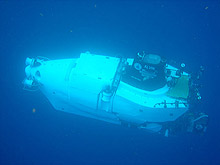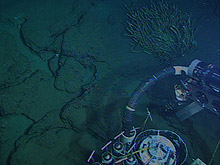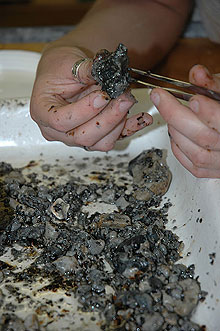
The deep submergence vehicle Alvin begins its descent to 1,200 m. Click image for larger view and image credit.
Filling in the Middle
May 10, 2006
Bob Carney
Benthic Ecologist
Louisiana State University
27° 22.39 N
090° 34.52 W
![]() A
sediment core is taken at Green Canyon. (Quicktime, 1.1 Mb.)
A
sediment core is taken at Green Canyon. (Quicktime, 1.1 Mb.)
Deep submergence vehicle (DSV) Alvin Dive 4174: the second dive of the Expedition to the Deep Slope, investigates a seep site at 1,200 m, a depth where our knowledge of the ecology is especially scarce. The information gap is equipment related. Initial studies of Gulf of Mexico seeps used the Johnson Sea-Link submersible operated by Harbor Branch Oceanographic Institute to explore seeps down to the sub's maximum operating depth of 1,000 m. Much less often, seeps at the base of the continental slope (2,500 to 3,500 m) have been explored using DSV Alvin, capable of diving much deeper. A picture of difference emerged. Seeps above 1,000 m have a distinct species community, and those at the slope base have a different combination of species. Two fundamental scientific questions arise: what processes cause the change, and what are seeps like that lie in the poorly studied middle depths? The main objective of Dive 4174 was to answer the second: at 1,200 m are the communities more like those shallower or those deeper?

This image, taken from DSV Alvin, shows a lone tubeworm bush growing among a number of porous carbonate boulders. Click image for larger view and image credit.
As the senior observer on today's dive, I was accompanied by first-time diver Helge Neimann, a biogeochemist at the Max Plank Institute in Germany. Expedition leader Pat Hickey piloted Alvin. The bottom was a pale landscape of muted brown and gray sediments. Carbonate rock outcrops and shallow depressions several meters across broke the monotony of the sediment cover. These seep features were scattered along a low ridge. The outcrops ranged from scattered piles of porous boulders to areas of much more solid looking rock, cracked and jumbled like shattered pavement. Tubeworm clusters sprouted from between the cracks.

Erin Becker from Penn State University searches for organisms hidden within an oil-stained sediment sample. Click image for larger view and image credit.
A long search for mussel mats and clam beds proved futile as one likely spot after another revealed only shell hash (accumulations of long-dead animals). The prevalence of so many dead animals is hard to understand since seepage continues to be active. Sediment sampling revealed both methane gas bubbles and liquid petroleum, which flows from the bottom as slowly rising black droplets. Helge directed core-sample collecting and attempted a trial deployment of a chemical sensor which will need additional adjustment before reliable measurements can be made.
Much analysis remains, but initial impressions are important. The fauna at this single site (Green Canyon 600) is distinctive in its own composition, but may have more in common with deeper communities than with shallower. Once the expedition completes mapping of species, we can start the process of figuring out why they are distributed as they are. Normal, non-seep fauna shows distinctive species change with depth. Scientists have explained this in terms of temperature, pressure, and food availability. If seeps have a similar depth pattern, we can eliminate food availability as a possible cause. Seeps manufacture their own food.
Sign up for the Ocean Explorer E-mail Update List.




























